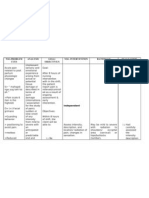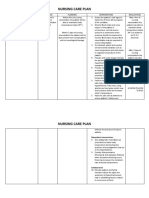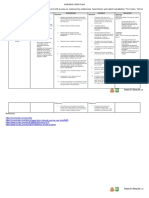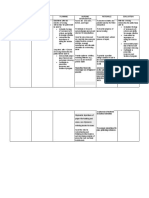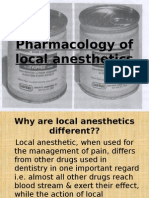NCP Hip Fracture
NCP Hip Fracture
Uploaded by
Cherry Ann BalagotCopyright:
Available Formats
NCP Hip Fracture
NCP Hip Fracture
Uploaded by
Cherry Ann BalagotOriginal Title
Copyright
Available Formats
Share this document
Did you find this document useful?
Is this content inappropriate?
Copyright:
Available Formats
NCP Hip Fracture
NCP Hip Fracture
Uploaded by
Cherry Ann BalagotCopyright:
Available Formats
COLLEGE OF NURSING
NURSING CARE PLAN
ASSESSMENT DIAGNOSIS PLANNING INTERVENTION RATIONALE EVALUATION
S – “Sobrang sakit ng Acute pain r/t muscle After 3 hours of nursing Independent After 3 hours of nursing
balakang ko!” as verbalized spasm, edema and injury to intervention the pt will be > Assess and record the pt’s level > For baseline data and to intervention goal was fully met
by the pt the soft tissue able to: of pain determine effectiveness of aeb:
interventions
O– > display relaxed manner > Position pt to a comfortable > Alignment of body > display of relaxed manner
> facial grimace > verbalize minimal pain position facilitates comfort; > pain level of 3
> guarding behavior (pain level of 2-3) positioning for function > demonstration of relaxation
> pain level of 4 out of 10 > demonstrate use of diminishes stress on skills and diversional activities
relaxation skills and musculoskeletal system
V/S – diversional activities > Maintain immobilization of > Immobilization relieves After 6 hours of nursing
T: 37 affected part using bed rest, cast, pain and prevents bone intervention the goal was partially
BP: 120/90 After 6 hours of nursing splint displacement and extension met aeb:
HR: 120 intervention the pt will be of tissue injury
RR: 22 able to: > Handle the affected extremity > Adequate support > pain scale of 2
gently, supporting it with hands diminishes soft tissue
> verbalize relief of pain or pillow tension
(pain scale of 0-1) > Perform and supervise active > Maintains strength and
and passive ROM exercises mobility of unaffected
muscles and facilitates
resolution of inflammation
in injured tissues
> Provide alternative comfort > Improves general
measures such as massage, circulation; reduces areas of
backrub, position changes local pressure and muscle
fatigue
> Identify diversional activities > It prevents boredom,
appropriate for patient age, reduces muscle tension, and
physical abilities, and personal can increase muscle
preferences strength; it may enhance
coping abilities
> Apply cold or ice pack first 24– > Reduces edema and
72 hr and as necessary hematoma formation
decreases pain sensation
> Assist with frequent changes in > Change of position
position relieves pressure and
associated discomfort
Dependent
> Apply Buck's traction if > Immobilizes fracture to
Submitted by: Submitted to:
GROUP 1 Ms. Myra Hasim
Student Nurse Clinical Instructor
prescribed decrease pain, muscle
spasm, and external rotation
of hip
> Administer medications as
prescribed:
– analgesics To reduce pain
– muscle relaxants To reduce muscle spasms
ASSESSMENT DIAGNOSIS PLANNING INTERVENTION RATIONALE EVALUATION
Submitted by: Submitted to:
GROUP 1 Ms. Myra Hasim
Student Nurse Clinical Instructor
S – “Nahihirapan akong Impaired physical mobility After 3 hours of nursing Independent After 3 hours of nursing
gumalaw sa sobrang sakit ng r/t pain or discomfort due to intervention pt will be able > Maintain neutral positioning of > Prevents stress at the site intervention the goal was fully met
balakang ko.” As verbalized fractured hip to: hip of fixation aeb demonstration of
by the pt > Instruct and assist in position > Encourages patient's techniques/behaviors that enable
> demonstrate changes and transfers active participation while resumption of activities
O– techniques/behaviors that preventing stress on hip
> inability/reluctant to move enable resumption of fixation After 48 hours of nursing
> limited ROM activities > Encourage participation in > Provides an opportunity intervention the goal was partially
diversional or recreational to release energy, refocuses met aeb:
After 48 hours of nursing activities. Maintain a stimulating attention, enhances patient’s
intervention pt will be able environment (radio, TV, sense of self-control and > regained mobility
to: newspapers, personal self-worth, and aids in > minimal strength of affected and
possessions, pictures, clock, reducing social isolation compensatory body parts
> regain/maintain mobility calendar, visits from family and
> inc strength/function of friends)
affected and compensatory > Teach patient or assist with > Increases blood flow to
body parts active and passive ROM muscles and bone to
exercises of affected and improve muscle tone,
unaffected extremities preserve joint mobility,
prevent contractures or
atrophy, and calcium
resorption from disuse
> Provide trochanter > Minimizes external
rotation
> Place in supine position > Reduces the risk of
periodically, if possible, when flexion contracture of the
traction is used hip
> Provide and assist with > Early mobility reduces
mobility aids such as complications of bed rest
wheelchairs, walkers, crutches, (phlebitis) and promotes
and canes healing and normalization
of organ function. Learning
the correct way to use aids
is important to maintain
optimal mobility and patient
safety
Dependent
> Administer analgesics as > To relieve pain
prescribed
> Refer to physical therapy > To ensure a consistent
department and more effective regimen
ASSESSMENT DIAGNOSIS PLANNING INTERVENTION RATIONALE EVALUATION
Submitted by: Submitted to:
GROUP 1 Ms. Myra Hasim
Student Nurse Clinical Instructor
S – “Nahihirapan akong Risk for impaired skin After 2 hours of nursing Independent After 2 hours of nursing
gumalaw sa sobrang sakit ng integrity r/t physical intervention pt will be able > Assess the overall condition of > Assessment of the intervention the goal was fully met
balakang ko.” As verbalized immobilization to demonstrate the skin condition of the skin aeb demonstration of
by the pt behaviors/techniques to provides baseline data for behaviors/techniques to prevent
prevent skin breakdown. possible interventions skin breakdown.
O– > Check on bony prominences
such as the sacrum, trochanters,
scapulae, elbows, heels, inner
After 24 hours of nursing and outer malleolus, inner and After 24 hours of nursing
intervention pt will be free outer knees, back of head intervention the goal was fully met
from wound/lesion. > Evaluate the patient’s strength aeb pt being free from
to move wound/lesion.
> Assess patient’s nutritional > An albumin level less
status, including weight, weight than 2.5 g/dL is a grave
loss, and serum albumin levels sign, indicating severe
protein depletion and at
high-risk of skin breakdown
> Massage skin and bony > Reduces pressure on
prominences. Keep the bed linens susceptible areas and risks
dry and free of wrinkles. Place abrasions and skin
water pads or padding under breakdown
elbows or heels, as indicated
> Reposition frequently > Lessens constant pressure
on the same areas and
minimizes the risk of skin
breakdown
ASSESSMENT DIAGNOSIS PLANNING INTERVENTION RATIONALE EVALUATION
Submitted by: Submitted to:
GROUP 1 Ms. Myra Hasim
Student Nurse Clinical Instructor
S – “Minsan ay nahihirapan Risk for falls r/t muscle After 3 hours of nursing Independent After 3 hours of nursing
akong tumayo.” As weakness and age-related intervention pt will be able > Place items the patient uses > Items that are too far may intervention the goal was fully met
verbalized by the pt physical changes to: within easy reach, such as call require the patient to reach aeb use of safety measures to
light, urinal, water, and telephone out or ambulate prevent falls and implementation
O– > demonstrate use of safety unnecessarily and can of strategies to increase safety and
measures to prevent falls potentially be a hazard or prevent falls
> implement strategies to contribute to falls
increase safety and prevent > Place beds are at the lowest > Keeping the beds closer After 24 hours of nursing
falls possible position. Set the to the floor reduces the risk intervention the goal was fully met
patient’s sleeping surface as near of falls and serious injury aeb pt not sustaining a fall.
the floor as possible if needed
> Raise side rails on beds, as
After 24 hours of nursing needed
intervention pt will not > Familiarize the patient with the > fall is more likely to be
sustain a fall. layout of the room. Discourage experienced by an
rearranging the furniture in the individual if the
room surrounding is not familiar,
such as furniture and
equipment placement in a
certain area
> Teach pt/SO how to safely > decreases the risk of falls
ambulate, including using safety
measures such as handrails in the
bathroom
> Provide appropriate room > Patients, especially older
lighting, especially at night adults, have reduced visual
capacity. Lighting an
unfamiliar environment
helps increase visibility if
the patient must get up at
night
> Make the primary path clear
and as straight as possible. Avoid
clutter on the floor surface
> Ask the family to stay with the > Helps prevent the patient
patient from accidentally falling
Submitted by: Submitted to:
GROUP 1 Ms. Myra Hasim
Student Nurse Clinical Instructor
You might also like
- Idoc - Pub Nursing Care Plan For Seizure NCPDocument2 pagesIdoc - Pub Nursing Care Plan For Seizure NCPACERET, IVAN LAURENTINE G.No ratings yet
- Subjective Cues:: Nursing Care ProcessDocument8 pagesSubjective Cues:: Nursing Care ProcessBianca Marithè RejanoNo ratings yet
- The Red EyeDocument71 pagesThe Red Eyehenok biruk80% (5)
- Acetaminophen PDFDocument1 pageAcetaminophen PDFTommieNo ratings yet
- Ncp. Acute PainDocument4 pagesNcp. Acute PainNathalie SamonteNo ratings yet
- NCP CSDocument4 pagesNCP CSJM UncianoNo ratings yet
- NCP-Acute PainDocument2 pagesNCP-Acute PainMatt Reyes Del CastilloNo ratings yet
- NCP For Gouty ArthritisDocument3 pagesNCP For Gouty ArthritisMolly HollyNo ratings yet
- GitDocument302 pagesGitjgcriste100% (7)
- NCP 2 MiDocument16 pagesNCP 2 MiWendy EscalanteNo ratings yet
- NURSING CARE PLAN 2 - Written ReportDocument3 pagesNURSING CARE PLAN 2 - Written ReportAkira PinedaNo ratings yet
- Sample of NCP and Drug Study EPO FINAL DRUG STUDYDocument8 pagesSample of NCP and Drug Study EPO FINAL DRUG STUDYSherina BolosNo ratings yet
- Assessment Explanation of The Problem Planning Nursing Intervention Rationale EvaluationDocument2 pagesAssessment Explanation of The Problem Planning Nursing Intervention Rationale EvaluationRodolfo Bong SemaneroNo ratings yet
- Tonsilitis & Allergic Rhinitis NCPDocument11 pagesTonsilitis & Allergic Rhinitis NCPJorgia SalardaNo ratings yet
- Galantine HBRDocument5 pagesGalantine HBRArone SebastianNo ratings yet
- EndocrinedisorderDocument3 pagesEndocrinedisorderDyan LazoNo ratings yet
- Multiple Sclerosis - NCPDocument5 pagesMultiple Sclerosis - NCPMonique Sacherow BacherNo ratings yet
- NCP InfectionDocument3 pagesNCP InfectionPrince AhmirNo ratings yet
- NCP Case Analysis GastritisDocument7 pagesNCP Case Analysis GastritisSteffi GolezNo ratings yet
- NCPDocument3 pagesNCPErica Denice CastilloNo ratings yet
- NCPDocument3 pagesNCPLeslie PaguioNo ratings yet
- Assessment Nursing Diagnosis Scientific Explanation Planning Intervention Rationale Evaluation IndeoendentDocument3 pagesAssessment Nursing Diagnosis Scientific Explanation Planning Intervention Rationale Evaluation IndeoendentDiane Sarino CabonceNo ratings yet
- NCP GCP FinalDocument15 pagesNCP GCP FinalssilvozaNo ratings yet
- NCP Self Care DeficitDocument3 pagesNCP Self Care DeficitLeizel ApolonioNo ratings yet
- FracturesDocument18 pagesFracturesNicole Anne ValerioNo ratings yet
- Nursing Care Plan: Cues Nursing Diagnosis Analysis Goal and Objectives Interventions Rationale EvaluationDocument3 pagesNursing Care Plan: Cues Nursing Diagnosis Analysis Goal and Objectives Interventions Rationale EvaluationCalimlim KimNo ratings yet
- NCPDocument6 pagesNCPNik Rose ElNo ratings yet
- Imbalnce Nutrition Less Than Body RequirementsDocument3 pagesImbalnce Nutrition Less Than Body RequirementselheezaNo ratings yet
- Nursing Diagnosis Nursing Intervention Rationale: Prioritized Nursing Problem For AnemiaDocument2 pagesNursing Diagnosis Nursing Intervention Rationale: Prioritized Nursing Problem For AnemiaMyrshaida Ibrahim0% (1)
- Part 1 - Nursing Care of A Family When A Child Needs Diagnostic or Therapeutic ModalitiesDocument37 pagesPart 1 - Nursing Care of A Family When A Child Needs Diagnostic or Therapeutic ModalitiesJustine Jean GuillermoNo ratings yet
- University of Cordilleras College of Nursing NCP: Mycobacterium TuberculosisDocument3 pagesUniversity of Cordilleras College of Nursing NCP: Mycobacterium TuberculosisLyn MhoreNo ratings yet
- Appendicitis NCPDocument5 pagesAppendicitis NCPEarl Joseph DezaNo ratings yet
- Incomplete Spinal Cord Injury Nursing Care Plan (ACTUAL) Patient's Name: Alvarez, Marcelo Age: 59y.o. Sex: M Address: Bacolod CityDocument6 pagesIncomplete Spinal Cord Injury Nursing Care Plan (ACTUAL) Patient's Name: Alvarez, Marcelo Age: 59y.o. Sex: M Address: Bacolod CityTherese MargaretNo ratings yet
- NCPDocument10 pagesNCPRobin HaliliNo ratings yet
- Predisposing Factors: Independent:: Assessment Cues Nursing Diagnosis Schematic Diagram Rationale EvaluationDocument2 pagesPredisposing Factors: Independent:: Assessment Cues Nursing Diagnosis Schematic Diagram Rationale EvaluationCarla Tongson MaravillaNo ratings yet
- NCP LupusDocument5 pagesNCP LupusMarwin OditaNo ratings yet
- NCP Hyperthermia Related To Underlying InfectionDocument2 pagesNCP Hyperthermia Related To Underlying InfectionNIKKI CARYL ZAFRANo ratings yet
- NCP ProperDocument9 pagesNCP Properstephanie eduarteNo ratings yet
- Assessment Diagnosis Planning Intervention Rationale EvaluationDocument2 pagesAssessment Diagnosis Planning Intervention Rationale EvaluationAriaNo ratings yet
- NCP Risk For Electrolyte ImbalanceDocument3 pagesNCP Risk For Electrolyte ImbalanceLouie ParillaNo ratings yet
- Lymphoma Case StudyDocument16 pagesLymphoma Case Studyapi-622273373No ratings yet
- Ncp. Oral MucosaDocument1 pageNcp. Oral MucosaZmiaNo ratings yet
- Nursing Care Plan: Cues Objectives Interventions Rationale EvaluationDocument2 pagesNursing Care Plan: Cues Objectives Interventions Rationale EvaluationJP2001100% (1)
- A Client With Cushing's Syndrome: Nursing Care PlanDocument1 pageA Client With Cushing's Syndrome: Nursing Care PlanJulius Caesar ColladoNo ratings yet
- San Francisco St. Butuan City 8600, Region XIII Caraga, PhilippinesDocument3 pagesSan Francisco St. Butuan City 8600, Region XIII Caraga, Philippineskuro hanabusaNo ratings yet
- Medications To Continue at Home Exercise Treatments Health Teachings Outpatient Diet Sexuality/ SpiritualityDocument2 pagesMedications To Continue at Home Exercise Treatments Health Teachings Outpatient Diet Sexuality/ SpiritualityMae EstilloreNo ratings yet
- Phenobarbital Risk For Injury EAMCDocument4 pagesPhenobarbital Risk For Injury EAMCkeitacNo ratings yet
- Problem: Pain at 6/10 For A "Sore Right Shoulder" Date Evaluated: December 14, 2020Document2 pagesProblem: Pain at 6/10 For A "Sore Right Shoulder" Date Evaluated: December 14, 2020florenzoNo ratings yet
- This Study Resource Was Shared Via: Nursing Care Plan FormDocument3 pagesThis Study Resource Was Shared Via: Nursing Care Plan FormissaiahnicolleNo ratings yet
- NCP Skin IntegityDocument3 pagesNCP Skin Integityclydell joyce masiarNo ratings yet
- Structuring Advanced Practice Knowledge An Internet Resource For Education and Practice (Autosaved)Document18 pagesStructuring Advanced Practice Knowledge An Internet Resource For Education and Practice (Autosaved)Dale Ros CollamatNo ratings yet
- Assessment Diagnosis Planning Intervention Rationale EvaluationDocument3 pagesAssessment Diagnosis Planning Intervention Rationale EvaluationKyla CalzadoNo ratings yet
- Impaired Physical Mobility R/T Neuromuscular ImpairmentDocument3 pagesImpaired Physical Mobility R/T Neuromuscular ImpairmentjisooNo ratings yet
- Impaired Skin IntegrityDocument2 pagesImpaired Skin Integritykingpin100% (1)
- Nursing Care Plan: Assessment Diagnosis Inference Goal Intervention Rationale EvaluationDocument4 pagesNursing Care Plan: Assessment Diagnosis Inference Goal Intervention Rationale EvaluationSugar Capule - ManuelNo ratings yet
- Diverticular DiseaseDocument8 pagesDiverticular Diseasenurse_enzo100% (1)
- Assessment Diagnosis Planning Intervention Rationale EvaluationDocument3 pagesAssessment Diagnosis Planning Intervention Rationale EvaluationgabbyNo ratings yet
- Chapter 6 - MCNDocument2 pagesChapter 6 - MCNPrincess Queenie OlarteNo ratings yet
- Subjective:: Assessment Diagnosis Planning Implementation Rationale EvaluationDocument2 pagesSubjective:: Assessment Diagnosis Planning Implementation Rationale EvaluationAyra PunzalanNo ratings yet
- Try This! Directions: Answer All The Necessary Information Needed in The Column Below. UseDocument10 pagesTry This! Directions: Answer All The Necessary Information Needed in The Column Below. UseChristine Joy Molina100% (1)
- Ventricular Septal Defect, A Simple Guide To The Condition, Treatment And Related ConditionsFrom EverandVentricular Septal Defect, A Simple Guide To The Condition, Treatment And Related ConditionsNo ratings yet
- NCP - Acute PainDocument2 pagesNCP - Acute PainNikita SignarNo ratings yet
- Life Extension Magazine 10Document100 pagesLife Extension Magazine 10tereNo ratings yet
- Rife Frequenciesfor CancerDocument9 pagesRife Frequenciesfor CancerFranquicio Perez Javier100% (2)
- Adaptive StrategiesDocument3 pagesAdaptive StrategiesAnandu PillaiNo ratings yet
- Presentation 2 - DR David SouthernDocument26 pagesPresentation 2 - DR David Southernশরীফ উল কবীরNo ratings yet
- Confirmed Case Press Release - April 16 - ENG V1 PDFDocument2 pagesConfirmed Case Press Release - April 16 - ENG V1 PDFBirhanu RetaNo ratings yet
- Valvular Heart DiseaseDocument54 pagesValvular Heart DiseaseRommanah AzmiNo ratings yet
- Diseases of The Five SensesDocument5 pagesDiseases of The Five SensesAlex CarrizoNo ratings yet
- Benson, D. Et Al. (1988) Posterior Cortical AtrophyDocument5 pagesBenson, D. Et Al. (1988) Posterior Cortical AtrophyLuis GómezNo ratings yet
- Hydris Hydris™: Disinfectant CleanerDocument1 pageHydris Hydris™: Disinfectant Cleanernikors65No ratings yet
- Digital SpirometerDocument50 pagesDigital SpirometerMoh FathiNo ratings yet
- Pad DR - IdarDocument75 pagesPad DR - IdarilvaNo ratings yet
- Alcain Peritoneal-DialysisDocument4 pagesAlcain Peritoneal-DialysisErika Trina AlcainNo ratings yet
- Distraction OsteogenesisDocument38 pagesDistraction OsteogenesisShah VidhiNo ratings yet
- A New Perspective On Metformin Therapy in Type 1 DiabetesDocument7 pagesA New Perspective On Metformin Therapy in Type 1 DiabetesdeckardmaxNo ratings yet
- AcetazolamideDocument4 pagesAcetazolamideAnkit RuhilNo ratings yet
- B.ing YenishacDocument3 pagesB.ing YenishacYenisha CherinaNo ratings yet
- Medical MnemonicsDocument107 pagesMedical MnemonicsdrabuelaNo ratings yet
- 1027-Article Text-3890-1-10-20220331Document6 pages1027-Article Text-3890-1-10-20220331setiawanNo ratings yet
- Circulatory SystemDocument11 pagesCirculatory SystemAlizaNo ratings yet
- BMJ 335 7630 CR 01147 Vaginal DischargeDocument5 pagesBMJ 335 7630 CR 01147 Vaginal DischargeHassan Abdullah AL-balushiNo ratings yet
- NICE Chest Pain GuidelineDocument33 pagesNICE Chest Pain GuidelineYesmi OrtegaNo ratings yet
- Local AnestheticsDocument93 pagesLocal Anestheticsgeetika100% (1)
- CHN Lec - Midterm TransesDocument25 pagesCHN Lec - Midterm TransesKaela ChoiNo ratings yet
- Basal Body TempDocument3 pagesBasal Body TempmyfilesNo ratings yet
- Precision AttachmentsDocument4 pagesPrecision AttachmentsPhoebe DavidNo ratings yet
- Magic Mouthwash Excerpt From 2014 Fall FPON JournalDocument1 pageMagic Mouthwash Excerpt From 2014 Fall FPON JournalM Abdul Aziz PNo ratings yet
- Area I Medical Surgical AsespsisDocument40 pagesArea I Medical Surgical AsespsisMeet JepsyNo ratings yet
- Ebooks File Davis's Drug Guide For Nurses 18th Edition April Vallerand All ChaptersDocument49 pagesEbooks File Davis's Drug Guide For Nurses 18th Edition April Vallerand All ChapterstalanaroysiNo ratings yet




